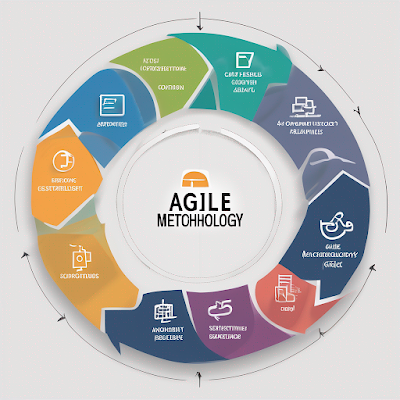Here is a 5,000+ character article on using Agile methodology in a Capstone project:
 |
| AGILE METHODOLOGY IN CAPSTONE PROJECT |
Introduction
Capstone projects are a key part of many college programs where students have the opportunity to apply the skills and knowledge they have gained from their studies to a substantial project. These projects allow students to demonstrate their proficiency through the successful completion of a real-world or simulated project. However, capstone projects can be complex undertakings that require careful planning and project management to achieve success. The Agile software development methodology is well-suited for capstone projects as it promotes an adaptive and flexible approach to managing changing requirements common in student projects. This article will explore how adopting Agile principles and practices can help students successfully complete their capstone projects.
What is Agile Project Management?
Agile project management is an iterative approach to managing the design, development and implementation of a product or project that focuses on continuous improvement and adapting to changing requirements. The Agile Manifesto, released in 2001, outlined four key values of Agile:
Individuals and interactions over processes and tools
Working software over comprehensive documentation
Customer collaboration over contract negotiation
Responding to change over following a plan
Several Agile methodologies have emerged that implement these values through iterative development cycles called sprints. The most common are Scrum, Kanban, Extreme Programming (XP), and Lean. All involve dividing work into small, achievable tasks; frequent inspection and adaptation; transparent communication; and team self-organization. The goal is to deliver working functionality frequently in short cycles rather than long periods of documentation and planning before development begins.
Benefits of Agile for Capstone Projects
There are several reasons why adopting an Agile approach can help students successfully complete capstone projects:
Changing requirements are inevitable in student projects as scopes are refined. Agile's iterative, adaptive nature makes it well-suited to responding to change without major disruptions.
Frequent delivery of working software/functionality provides early feedback to validate assumptions and direction. This reduces risks of building the wrong product or feature.
Transparent collaboration keeps all stakeholders (student, faculty advisor, external partners) aligned on progress, issues and upcoming work. Clear communication is critical on student projects.
Self-organizing teams promote autonomy and responsibility, preparing students for independent work expected after graduation. Agile teaches valuable project management and professional skills.
Short sprints keep work modular and tasks focused. This prevents losing motivation that can happen with massive, long-term tasks in traditional "waterfall" projects.
Documentation is still produced but "just in time" rather than extensive analysis paralysis up front. Working software is the primary measure of progress.
Responding to change is a reality of exploration and learning. Agile embraces rather than fears adjustment which better reflects the student experience.
Implementing Agile for a Capstone
For a capstone project, students can benefit from implementing Scrum, one of the best known and most straightforward Agile frameworks. The basic Scrum roles, events and artifacts provide an effective structure:
Roles:
Product Owner - Student determines vision and prioritizes features
Scrum Master - Faculty advisor facilitates the process
Development Team - Student(s) completing the work
Events:
Sprint Planning - Student plans 2-4 week sprints with advisor
Daily Scrum - Brief check-ins keep work on track
Sprint Review - Demonstrate working product/feature at end
Sprint Retrospective - Continuous improvement discussions
Artifacts:
Product Backlog - Prioritized features and tasks
Sprint Backlog - Incremental plan for current sprint
Burn Down Chart - Work progress visualization
Some additional tips:
Start with a Skeleton rather than fully designing architecture. Get early feedback.
Keep sprints short (2 weeks max) to maintain pace and interest.
Focus on one goal/definition of done per sprint to ensure delivery.
Maintain transparency through documentation in Github, Jira etc.
Candidly discuss challenges at retrospectives to strengthen process.
Get external stakeholder feedback regularly to validate work.
Have fun! Focus on continual learning over rigid outputs.
By treating their project like an Agile software team, students gain project management skills applicable in any field. Managing changing priorities effectively and collaboratively is a major asset post-graduation. With improved clarity, communication and adaptation, Agile helps capstone projects become a richer learning experience.
No comments:
Post a Comment